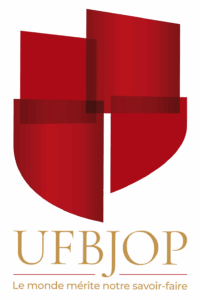SPECIAL REPORT
MARKETING & EDUCATION


PHOTO CREDIT: Montage using photos by Andrea Piacquadio (https://www.pexels.com/photo/woman-holding-books-3768126) and by The New York Public Library on Unsplash.
The spread of knowledge as a safeguard
to ensure the jewellery industry’s future

By Jonathan Kendall
President
CIBJO Marketing & Education Commission
AUGUST 21, 2025
Although it has served as a jewellery industry resource for knowledge and learning since its very founding, some 99 years ago, CIBJO’s formal recognition of its educational role can be dated back to December 2008, when it registered in Berne, Switzerland, the Jewellery Confederation Education Foundation (WJCEF) as a non-profit organisation. This followed a vote in April of that year at the CIBJO Congress in Dubai, UAE, which called for the establishment of a dedicated educational foundation.
But the roots of WJCEF can actually be traced back to 2006, when CIBJO was accepted as a member of the United Nations Economic and Social Council (ECOSOC), becoming the first and only representative of the greater jewellery industry to be officially granted consultative status by the United Nations.
A year later, in October 2007, CIBJO organised a day-long conference at the UN Palais des Nations complex in Geneva, Switzerland. Convened to investigate how a model could build for the jewellery sector to promote its contribution to the UN development programme, it was there that an initial action plan was introduced for the development of a comprehensive educational infrastructure.
In the years since, CIBJO has continued to support educational activities across the industry through a range of programmes providing training, education and guidance. Many are related to responsible business practices, but its perspective has broadened to include the full range of activities that CIBJO covers in respect of the greater jewellery industry, its stakeholders and its consumers.
This year’s special report focuses on two more recent projects, both of which will shape the organisation and industry moving forward – the CIBJO Academy and the International Fine Jewellery Academy (IFJA).
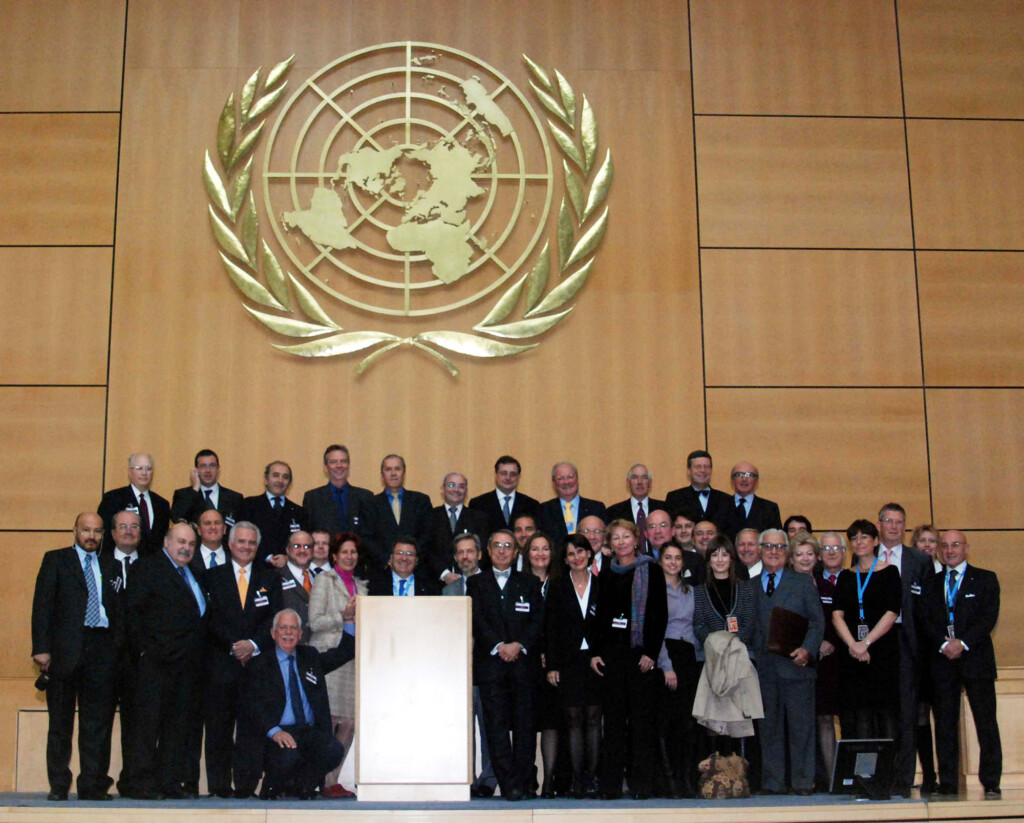
Members of CIBJO are hosted by the UN Development Agency at United Nation’s Palais des Nations in Geneva in October 2007. It was here that was proposed the creation of a dedicated educational infrastructure, which a year later was established as the World Jewellery Confederation Education Foundation (WJCEF).
The establishment of the CIBJO Academy
The CIBJO Academy was established in 2023 as the central pillar of a programme to educate both the jewellery industry and its consuming public about the standards, operating principles and terminology that has been developed over the years by CIBJO’s commissions and expert committees.
“Year in and year out, the various working groups within CIBJO have worked to produce and keep up to date what are undoubtedly the most authoritative sets of harmonised standards and nomenclature in the jewellery industry,” said World Jewellery Confederation President Gaetano Cavalieri, when he introduced the soon-to-be-formed body at the VizcenzaOro jewellery show in Vicenza, Italy. “They have formed the basis of a number of ISO standards and various government regulations and have guided gemmologists and standards compliance bodies throughout the industry. But, because they often are voluminous and very technical, we felt they that they often do not reach the grass roots of the business. The role of the CIBJO Academy will be to remedy this, providing easy and comprehensible access to what is a treasure-trove of knowledge and research.”
To further its mission, the academy was charged with the preparation and delivery of educational programmes and materials, suitable for both jewellery professionals and the consuming public. This it would do via multiple platforms including the CIBJO website, social media, webinars and live in-person events. The content would need to be relevant to the entire spectrum of the gemstone and jewellery industries and cover natural diamonds, laboratory-grown diamonds, coloured gemstones, pearls, coral, precious metals, principles of responsible sourcing, the operation of gem laboratories, marketing, and more.
One of the world’s most respected gemmologists and educators, Kenneth Scarratt, was selected as the academy’s first Dean. He also serves as a CIBJO Vice President, and is President of Sector A, which covers all gem materials, and President of the CIBJO Pearl Commission.

World Jewellery Confederation President Gaetano Cavalieri announcing the plan to launch the CIBJO Academy, before the start of a CIBJO-organised seminar at the VicenzaOro show in Vicenza, Italy, on January 22, 2023. He is joined on stage by Kenneth Scarratt, who was appointed Dean of new academy.
CIBJO Academy courses get under way
Working in conjunction with the presidents of the various CIBJO Commissions, Mr. Scarratt set out to prepare a series of presentations, geared for delivery both in-person and online, on industry best practices as set out in the CIBJO Blue Books. They varied in length from 30 minutes to three hours, with each focusing on a specific topic.
The academy’s first three-day course, which was tailored specifically for jewellery industry professionals, took place in October 2024, at the Gem and Jewelry Institute of Thailand (GIT) in Bangkok. It was led by Mr. Scarratt himself, working alongside GIT Deputy Director Thanong Leelawatanasuk and Dr. Bhuwadol Wanthanachaisaieng, Chief of GIT’s Research and Standards Department. Attendees were provided an overview of both technical and due-diligence standards, as they relate to precious metals, coloured stones, diamonds, pearls and precious coral, with an emphasis on transparent and unambiguous disclosure, responsible sourcing and sustainable environmental practices.
The idea of collaborating with industry organisations is a core component of the CIBJO Academy’s delivery strategy. Programmes similar to those being conducted in Thailand are currently being planned with industry associations in Bahrain, Germany and Italy.
Additionally, Mr. Scarratt has presented over the past year at a number of industry events, including during the long-standing seminar series that CIBJO organizes together with the Italian Exhibition Group, the organizer of VicenzaOro, each January and September. There the programme focuses mainly on topics related to responsible sourcing, practices and sustainability in the jewellery industry.
Currently being planned is a series of CIBJO Academy sessions presented on-line and in-person by Rui Galopim de Carvalho, a popular gemmological educationalist. Details of the programme will be announced in September or October of this year.

CIBJO Academy Dean Kenneth Scarratt lecturing to attendees at a seminar organized together with the the Gem and Jewelry Institute of Thailand (GIT) in Bangkok.
Going beyond the CIBJO Blue Books
The fundamental course material for the CIBJO Academy remain the CIBJO Blue Books, presenting definitive standards for diamonds, coloured gemstones, pearls, coral, precious metals, gemmological laboratories and responsible sourcing. But increasingly there is a focus on information that goes beyond them, and this is being contained in a growing series of guides designed and developed by expert working groups operating under CIBJO’s umbrella.
Several of these guides have already been incorporated into the CIBJO Academy’s coursework and are available for downloading free-of-charge online from the CIBJO website.
One of first such guides to be created was the “The CIBJO Guide for Classifying Natural Pearls and Cultured Pearls,” a 62-page illustrated document that provides an overarching view of natural and cultured pearls, from both seawater and freshwater sources, and highlights the important parameters by which their appearance can be described and assessed in terms of physical dimensions and quality.
An updated edition of the pearl guide is currently nearing completion. Running more than 260 pages, it will be encyclopaedic resource of general information about the many varieties of natural and cultured pearls and the molluscs that create them. It will go beyond its predecessor in describing the important parameters by which the appearance of natural pearls can be described and assessed, from the Akoya species complex and cultured pearls produced, along with other of the “pearl oysters” as well as freshwater molluscs. The issue of sustainability of pearls is dealt with from many perspectives, with case studies provided to clarify the situation in various parts of the world. The differences between classification and grading are fully explained, and the guide will elucidate the five pearl classification systems that are currently used.
An updated “Precious Coral Guide” has already been uploaded to the CIBJO website. It provides invaluable insights into this ancient gem material, detailing all the available coral varieties, be they of the limited precious coral category, or otherwise, as well as up-to-date details of where precious coral is fished, and the local regulations that control and prevent over-fishing, and the conservation aspects that maintain the precious coral supply chain.
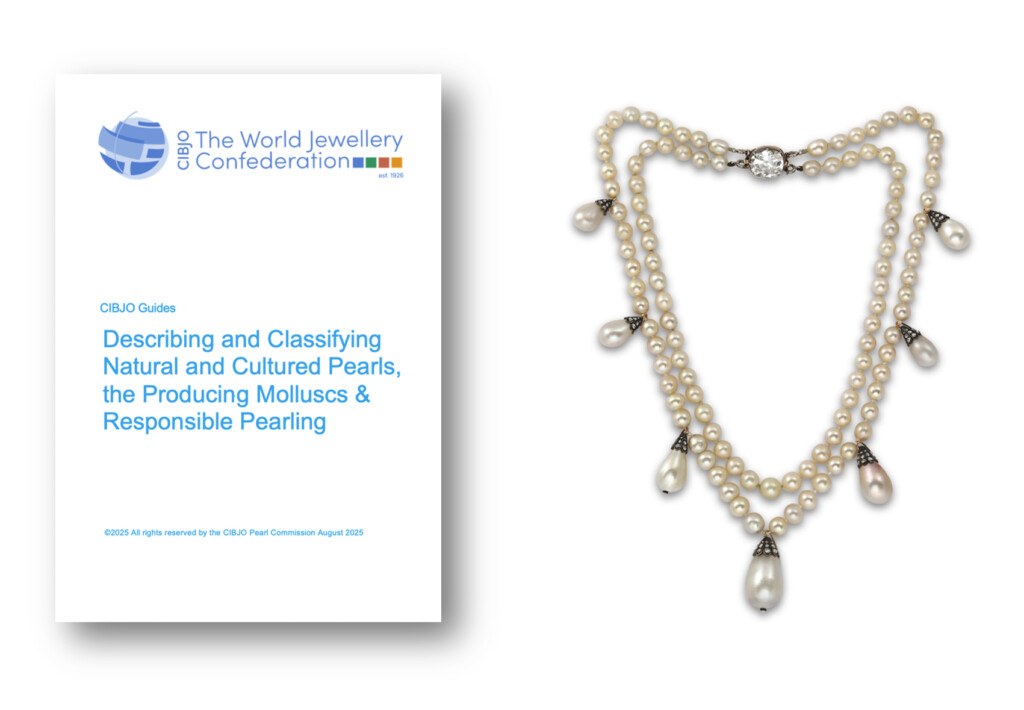
The soon-to-be-released update to the CIBJO Pearl Guide, which at 260 pages in length is an encyclopaedic resource of information about both natural and cultured pearls.

The recently released update of the CIBJO Coral Guide, providing information about the various coral varieties and their environmental management.
New guides in preparation
Other guides are currently in the final stages of preparation. One deals with jade and jadeite, which are amongst the most popular of coloured gemstones in China and other East Asian countries. This is a gemstone variety for which the world has maintained a divided nomenclature for hundreds of years, raising the risk of miscommunication, which may result in considerable financial and reputational costs. The guide will provide clarity to the Fei Cui nomenclature that is used in China, cross-referencing it that with the terminology used elsewhere. It also will detail mining localities, treatments, imitations and synthetics.
Another prospective guide focuses on opal, for which understanding its properties and nuances in its descriptive nomenclature has long been a challenge in non-producing countries, and indeed in some instances within and between the producing countries themselves. During meetings of the CIBJO Coloured Stone Commission over a period of years, it became obvious that a guide was needed to standardise to the greatest degree possible the descriptions of various types of precious and common opal.
The new Opal guide will describe and classify the gemstone in its many differing types and localities. It will also detail treatments that may be applied.
Another guide, which is still in the early stages of preparation, will tackle the challenges associated with jewellery appraisal and valuations, in countries around the world, assisting all those involved or wanting to be involved in this challenging field. To develop it an expert working group has been formed, with a group of preeminent experts making up its membership. We are anticipating a truly groundbreaking educational document that will cover appraisals and valuations on a global scale.
Once complete, all the new guides will become part of the CIBJO Academy’s offering, as well as being made available for downloading from the CIBJO website.
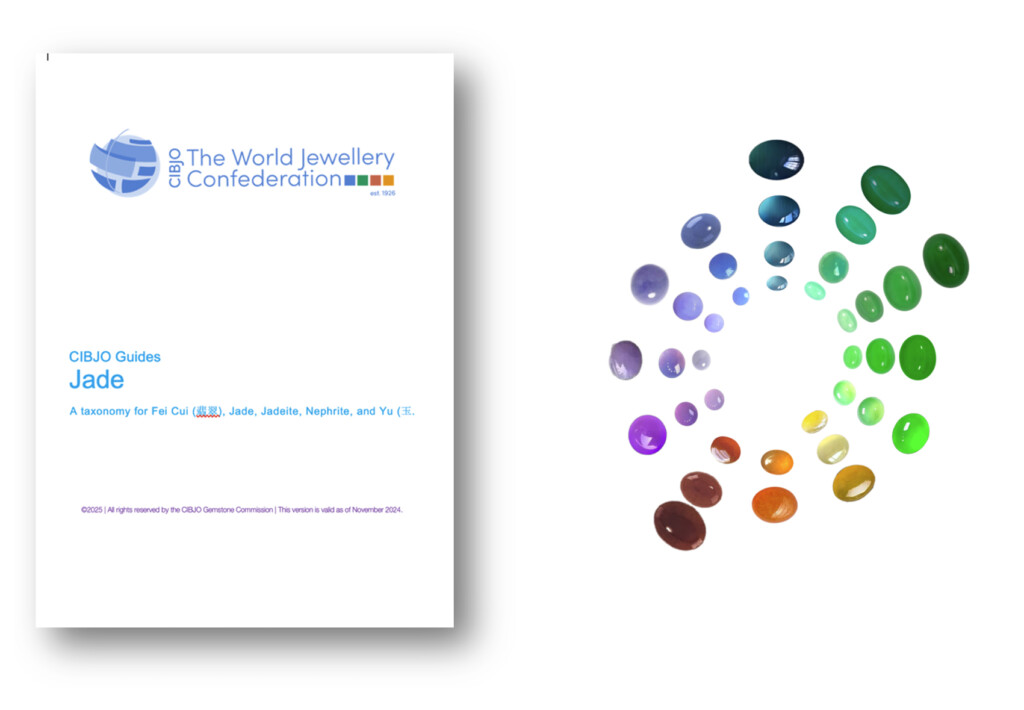
The soon-to-be-released CIBJO Jade Guide, which provides clarity to the Fei Cui nomenclature used in China, cross-referencing it to terminology used elsewhere.
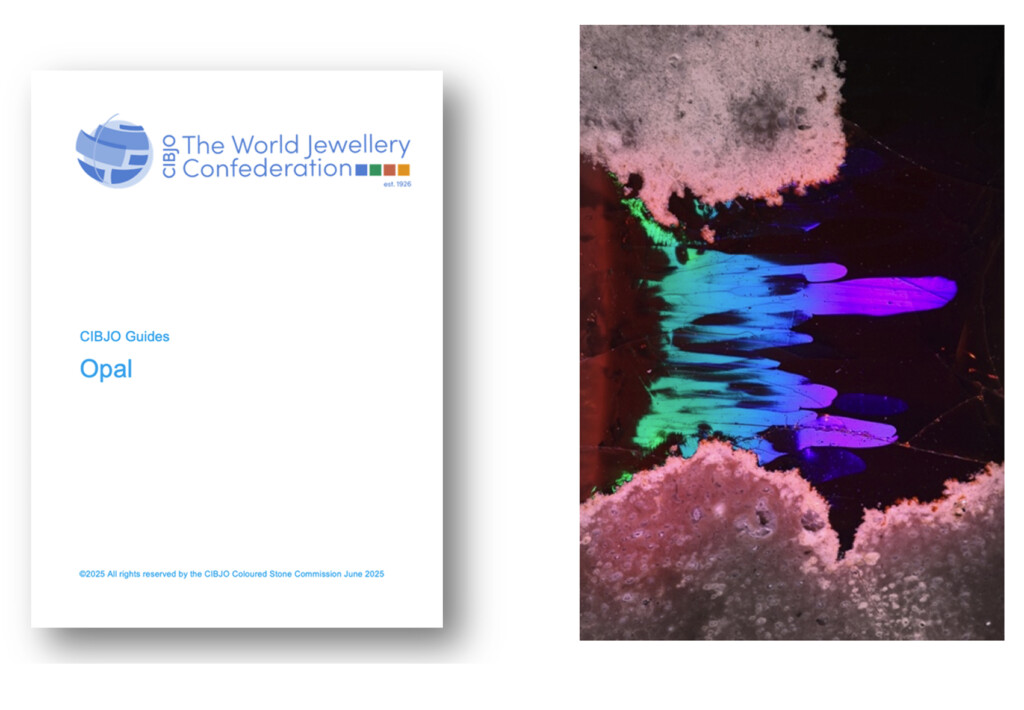
The soon-to-be-released CIBJO Opal Guide, which provides standardized descriptions for precious and common opal found in different parts of the world.
The International Fine Jewellery Academy (IFJA)
Alongside the CIBJO Academy, which focuses predominantly on grading and identification standards, principles and nomenclature, the World Jewellery Confederation’s educational programme is expanding its focus to training in the jewellery craft.
On September 6, 2025, during a presentation before audience gathered at the VicenzaOro jewellery show in Italy, CIBJO is scheduled to formally launch what almost certainly will become the largest and most ambitious educational initiative it has undertaken on behalf of the jewellery industry to date. Called the International Fine Jewellery Academy (IFJA), the project involves the establishment of new educational institute that will be based in Milan, Italy. Serving students that will travel in from around the world, it will leverage the centuries-old traditions, knowledge and experience contained in the Italian jewellery sector, preserving and passing them on to future generations.
IFJA is being created as a partnership involving CIBJO; ConfCommercio, Italy’s largest trade association, which is active in 155 different sectors, including jewellery; Foundation Mani Inteligenti, a body based in Valenza whose mission is to train the next generation of Italian goldsmiths; and CAPAC – Politecnico del Commercio e del Turismo, a non-profit foundation that has been operating in the professional training sector since 1961.
As part of the venture, CAPAC will provide the International Fine Jewellery Academy facilities in the centre of Milan, where in-person training and education will take place. This will be complemented by hands on training delivered by some of the world’s most skilled jewellery artisans, at partner companies in northern Italy.
IFJA will be more than just another institution. It is intended to transform the landscape of jewellery education. By fusing the international thirst for knowledge with the principes developed within CIBJO and with the renowned values of Italian craftsmanship, it aspires to set a new standard for talent development in high-end jewellery manufacturing.
At the heart of IFJA’s mission is the belief that education should provide more than just a career pathway—it should be a transformative life opportunity.


PHOTO CREDIT: Photo by Luca Sammarco: (https://www.pexels.com/photo/galleria-vittorio-emanuele-ii-in-milan-6589184)
The Italian city of Milan, a world fashion and design centre, will be the location of one of the most ambitious educational projects ever undertaken by CIBJO, the International Fine Jewellery Academy (IFJA), which is being done in partnership with ConfCommercio, Foundation Mani Inteligenti and CAPAC – Politecnico del Commercio e del Turismo.
Classroom instruction and hands-on training
IFJA will target students from ages 19 to 30, provide specialized courses ranging from 250 to 1,000 hours, including on-the-job training with partner companies. The hands-on approach will ensure that students not only learn theory but also gain practical experience, which is crucial in the high-skill vocational field of jewellery. Classroom instruction will be in English.
The fact that IFJA is strategically situated in Milan, a global hub for fashion and luxury, is especially significant, especially because much of IFJA’s hand-on training will take place at jewellery companies located in and around the Italian city.
The academy plans to create an urban-learning ecosystem that fosters a sense of community among students, enhancing their educational experience through a collaborative living and learning environment. It is envisioned that housing solutions will be provided to students, in residence-style accommodations, either spread across the city or within a single facility, shared with other students.
Initially, during its the start-up stage, IFJA will have at least one fully equipped production lab and one theoretical classroom, at the CAPAC training facility. But a partnership with a state vocational institute is planned and, through it the organisers foresee a doubling of the lab spaces and expanding up to five the number of classrooms dedicated to theory. This is expected to take place over a three-to-five-year period from the launch of operations.
The quality of the faculty and content governance will be key to ensuring IFJA’s reputation, and its ability to attracting talent and students from around the world. The model being developed includes “train the trainer” programmes and the customized educational paths based on the needs and capacity of both students and partner companies.

The CAPAC – Politecnico del Commercio e del Turismo building in Milan, which will serve as the physical location of the International Fine Jewellery Academy (IFJA).
We seek your input
Education and training is of paramount importance to those working across the jewellery industry and is now undoubtedly one of CIBJO’s core value propositions. We will continue to focus and deliver on this in the coming year and beyond.
Our developments in these areas will continue as they become increasingly important and we will be providing further information, guidance and resources to help the industry improve in areas such as traceability, sustainability, and the preservation of historic legacy.
We are always seeking feedback, and we value your views about what aspects of training and education you believe we should develop in future. Thank you for your engagement and support.



